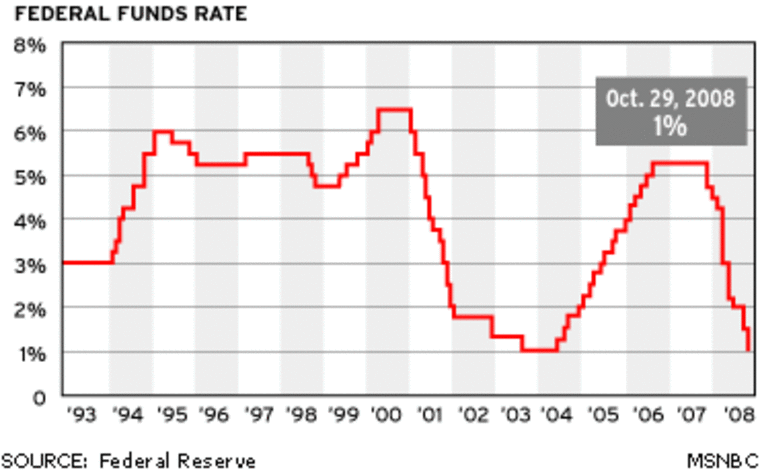Federal Reserve Chairman Alan Greenspan and his colleagues boosted short-term interest rates for a 13th straight time Tuesday but signaled they have moved into the end game of their 18-month campaign to limit growth and inflation.
The central bank boosted rates another quarter-percentage point as expected but removed any reference to monetary policy "accommodation," suggesting policy-makers believe rates are no longer so low that they stimulate economic growth.
The move brings the benchmark overnight lending rate to 4.25 percent, compared with a 46-year low of 1 percent when the central bank began its rate-hike campaign in June 2004. The current rate is the highest since May 2001, raising borrowing costs for a broad range of loans to consumers and businesses.
Stock prices surged as investors welcomed the news that the Fed may be done raising rates soon. The Dow Jones industrial average ended with a gain of about 56 points after surging in the minutes after the Fed announced the rate change along with the new statement.
"The good news is there is an end game in sight. The bad news is it is not likely to be over at the end of Chairman Greenspan's term," said Diane Swonk, chief economist for Mesirow Financial in Chicago.
After more than 18 years in office, Greenspan steps down Jan. 31, immediately following one final meeting of the Fed's policy-making Open Market Committee. Another quarter-point hike is expected at that meeting, and then former Fed Gov. Ben Bernanke will take over, presuming he wins Senate approval.
Bernanke is expected to follow recent tradition by orchestrating a rate hike at his initial meeting in March, analysts are divided on what will happen next. Some expect the Fed to move to the sidelines for at least a few months, while others believe more rate hikes are likely. In any case, the shift in Fed language begins the process of transitioning to a new Fed chief, analysts said.
"This statement effectively got the Fed out of the 'quarter-point at every meeting forever' phase," Swonk said. "It opens the way for Ben Bernanke to set his own agenda."
"The key here is that the Fed has been making promises, commitments to rate changes," said Tony Crescenzi, chief bond market analyst for Miller, Tabak & Co. "The Fed is no longer on automatic pilot. Bernanke won't be under pressure and instead can let the data dictate future changes."
Tuesday's statement marked the first time the Fed has not referred to an "accommodative" policy or monetary "accommodation" since December 2001, when the overnight federal funds rate was under 2 percent and the economy was just emerging from recession, with the outlook still highly uncertain after the shock of the 9/11 terrorist attacks.
Policy-makers made clear they expect to hike rates at least one more time next year — and probably more. The Fed said "some further measured policy firming is likely to be needed to keep the risks to the attainment of both sustainable economic growth and price stability roughly in balance."
That means monetary policy is likely to move from a neutral level to a stance that could restrict growth, raising the danger that the Fed could "overshoot" and contribute to an economic slowdown in the second half of next year or 2007, analysts said.
But there is still enough danger of inflation to require the Fed's vigilance. The Fed statement said "possible increases in resource utilization as well as elevated energy prices have the potential to add to inflation pressures."
In fact, while many analysts think the Fed will stop raising rates by mid-2006, once the benchmark rate hits 4.75 or 5 percent, others think the central bank will go higher.
Rich Yamarone of Argus Research said the Fed is likely to push its benchmark rate up to 5.5 percent due to inflation pressures. “Energy prices are not altogether back in safe territory,” he said, ticking off recent increases in natural gas prices, a lack of production from Gulf oil platforms affected by Hurricane Katrina and a recent increase in the government’s long-term oil price projection.
While the Fed does not affect long-term interest rates directly, over the past several months they have been drifting higher as well, possibly bring the high-flying housing market down a bit. Rates on popular 30-year mortgages , and even housing industry executives expect sales and construction activity to slow in 2006, removing one of the most important contributors to growth over the past several years.
After the announcement of the Fed committee's decision, which was unanimous, leading commercial banks followed in lock-step by raising their prime lending rate to 7.25 percent. The Fed's less commonly used discount rate also was raised a quarter-point to 5.25 percent.
Recent reports have suggested the economy is growing at a steady clip, having gotten beyond a slowdown caused by Hurricane Katrina and other disruptions that sent energy prices soaring and left tens of thousands of people homeless and unemployed.
But retail sales were surprisingly sluggish in November, the Commerce Department reported Tuesday, a worrisome development at the start of the holiday shopping season.
